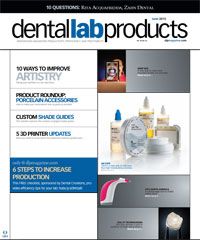5 3D printing trends you should know
3D printing is an ever growing part of the dental industry.
3D printing is an ever growing part of the dental industry.
And it’s come a long way since its beginnings-the days of single use printing technology and slow print speed are gone, replaced by a variety of utilities and speedy print times. Here are 5 of the 3D printing advances you need to know about:
1. New technology
This might seem obvious, but if you haven’t checked out 3D printers, you might be amazed at how far they’ve come. New technology makes them faster, more accurate and able to produce a wider variety of tasks and end products. We’re no longer in the “early adopter” phase of 3D printing-the technology has developed enough to make it a viable option for many more labs.
The List: Top 3 reasons you might be ready for a 3D printer
2. New materials
The materials used by 3D printers are advancing at a stunning speed. What used to be a technology that was useful for a limited number of cases has expanded to include a huge variety of possibilities. New materials mean more and more lifelike models, printable temporaries and, eventually, even printable dentures that use separate colors and materials for the base and teeth. Though it’s not “printing” in the traditional sense, SLM (selective laser melting) is also growing in the material arena, allowing even noble metals to be “printed” in a variety of ever-increasing options.
3. Business opportunities are growing
Once upon a time, there were really only two or three possible uses for a printer, and most of those had to do with model making. But now, thanks to increases in both printing and SLM technology, there are more options than ever. You can “print” substructures and frames using an SLM system, making the construction of fixed restoratives or removables simple. With 3D printing, you can print models, or you can print surgical guides, wax patterns or other options in a variety of sizes and uses. 3D printing provides a good way to break into new and exciting business arenas.
4. Improving existing workflows
With material and technology improvements come the ability to improve your workflows via 3D printing. Models are created faster, leaving you more time to actually make the restoration, and the increase of intraoral scans and digital impressions provides an immediately printable model option. Plus, printing with lifelike color and texture gives you a better feeling how your restorative solutions will look in the patient’s mouth, and shipping the restoration on a 3D printed model makes the restoration look even better.
Free webinar: What 3D printing can bring to your lab
5. Bigger isn’t always better
For simpler tasks, we’re also seeing smaller and smaller 3D printing solutions that can create printed objects that used to take a huge machine to produce. And with that smaller size often comes a smaller price. These smaller printers might not be able to do everything their bigger siblings can, but, for basic work, having a printer the size of an inkjet printer or a mini-fridge is a no-brainer. It seems to be a rule of technology: The longer tech is around, the smaller it gets. That’s certainly proving to be true with 3D printers.
This article originally appeared in the June 2015 issue of Dental Lab Products. Click here to subscribe and never miss an issue: http://bit.ly/18S8j4i
Photo: akindo, Getty Images
Product Bites – January 19, 2024
January 19th 2024Product Bites makes sure you don't miss the next innovation for your practice. This week's Product Bites podcast features new launches from Adravision, Formlabs, Owandy Radiology, Henry Schein Orthodontics, Dental Creations, and Dental Blue Box. [5 Minutes]
3D Systems Garners FDA Clearance for Multi-material, Monolithic Jetted Denture Solution
September 17th 2024The company’s unique multi-material, single-piece dentures are designed to offer a combination of distinctive break resistance and outstanding esthetics for enhanced patient experience, and Glidewell labs are currently implementing the solution.
